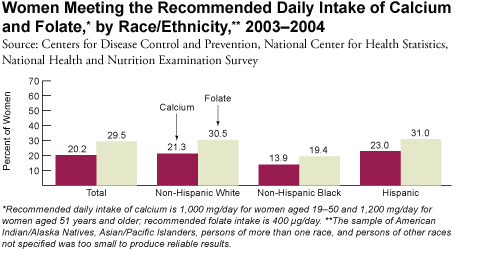Nutrition
The Dietary Guidelines for Americans, 2005 recommends eating a variety of nutrient-dense foods while not exceeding caloric needs. For most people, this means eating a daily assortment of fruits and vegetables, whole grains, lean meats and beans, and low-fat or fat-free milk products while limiting added sugar, sodium, saturated and trans fats, and cholesterol.1
Some fats, mostly those that come from sources of polyunsaturated or monounsaturated fatty acids, such as fish, nuts, and vegetable oils, are an important part of a healthy diet. However, high intake of saturated fats, trans fats, and cholesterol may increase the risk of coronary heart disease. Most Americans should consume fewer than 10 percent of calories from saturated fats, less than 300 mg/day of cholesterol, and keep trans fatty acid consumption to a minimum. In 2003–2004, 63.5 percent of women exceeded the recommended maximum daily intake of saturated fat—most commonly non-Hispanic White women and non-Hispanic Black women (65.9 and 64.4 percent, respectively).
Salt, or sodium chloride, also plays an important role in heart health, as high salt intake can contribute to high blood pressure. In 2003–2004, nearly 70 percent of women exceeded the recommended maximum intake of less than 2,300 mg/day of sodium, or about 1 teaspoon of salt (data not shown).
Calcium is important for strengthening bones and teeth, and inadequate calcium consumption can lead to lower bone density, bone loss, and increased risk of osteoporosis. The recommended intake of calcium is 1,000 mg/day for women aged 19–50 and 1,200 mg/day for women aged 51 years and older. In 2003–2004, 20.2 percent of women met or exceeded the recommended daily intake. Folate is also an important part of a healthy diet, especially among women of childbearing age, since it can help reduce the risk of neural tube defects early in pregnancy. In 2003–2004, fewer than 30 percent of women consumed the recommended daily intake of folate (400 μg/day). Fewer than 20 percent of non-Hispanic Black women consumed the recommended amount of folate, compared to more than 30 percent each of non-Hispanic White and Hispanic women.
1 U.S. Department of Health and Human Services; U.S. Department of Agriculture. Dietary Guidelines for Americans 2005. Washington, DC: U.S. Government Printing Office, January 2005.↑


